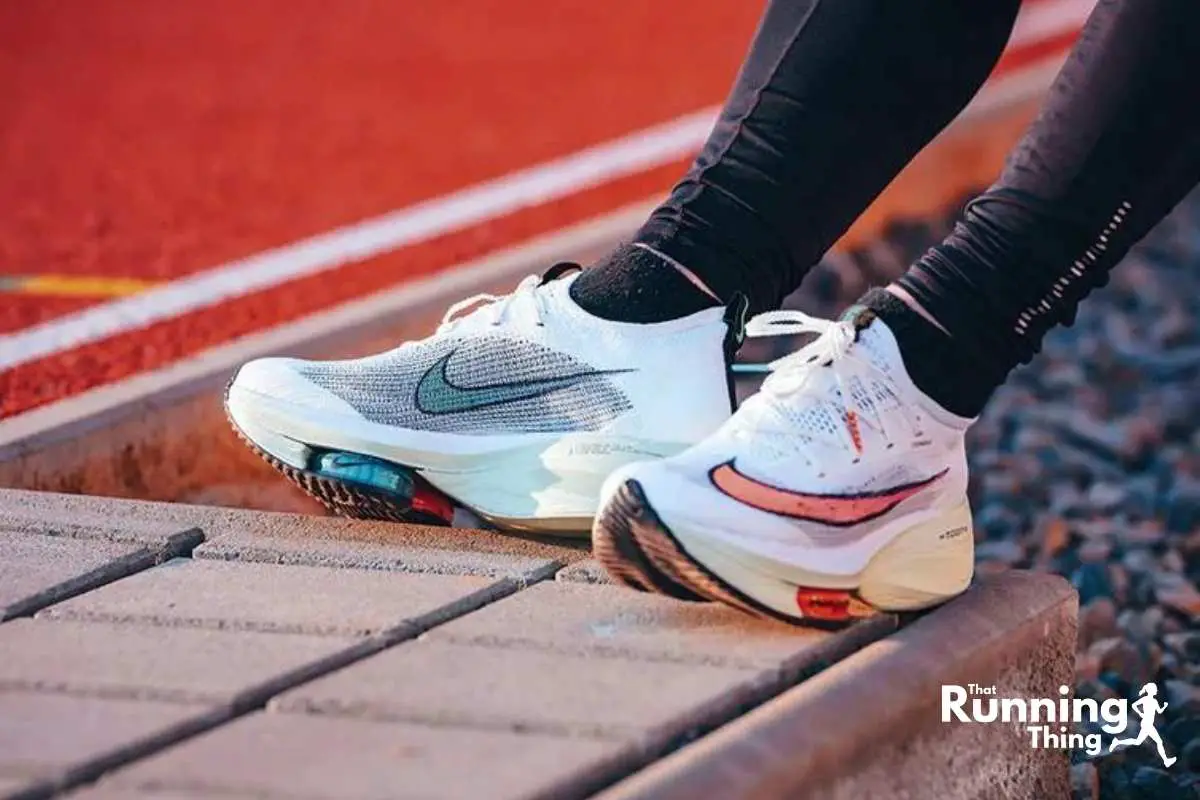Reebok was the first company to release running shoes with a carbon plate in the 1990s. They released the shoe Graphite Road, which had a carbon bridge found near the midfoot of the shoe.
The shoe designers set the goal to increase the platform’s stability and enhance the energy return that you feel from the cushioning with extra stiffness. You may wonder if carbon plate running shoes would make sense for you.
Let’s have a look at the pros and cons of going in-depth with each, and I’ll let you make up your own mind from there.
| Pros | Cons |
| 1. Saves Energy | 1. More expensive |
| 2. Increases speed | 2. Shorter lifespan |
| 3. Good for stability and sipport | 3. Not all models for competition |
| 4. Good for tempo runs | 4. Only better running performance for higher speeds |
| 5. Big and stronger calves | 5. Not good for shorter events |
| 6. Good for ultramarathons | |
| 7. Prevents injury |
Pros of Carbon Plate Running Shoes
#1: Saves Energy
Whenever you run, your toes will bend—a lot. A rigid running plate that runs the full length of the shoe will reduce the toe-bending motion. The joints of your toes remain stiff in a carbon running plate to save energy with each step.
The carbon running plate increases your return energy. For example, you use energy with each stride, but the shoe becomes a type of springboard that will propel you forward faster. Carbon plate running shoes could store as much as 87% return energy.
That amount of energy is much higher than the other running shoes. Most running shoes return somewhere between 50 and 60%.
Oftentimes, you will hear runners describe return energy as a “Pleasant snap.”
#2: Improves Speed
Carbon fibre weighs less than other shoes, which will improve your speed. I won’t claim that the difference will be huge, but even 4% in a marathon race can mean the difference between winning and losing. I say 4% because the Nike Vaporfly running shoe claims to improve speed by 4%.
This running shoe has a full-length carbon plate that propels runners forward. Not everyone believes in this, however, and one study cut the carbon fibre plate in half, and they found that it made no difference to the running economy.
With everything said, I would like to highlight that this may make no difference to a beginner. You can improve your speed far more if you refine your running form.
Especially as a beginner, you will need to improve your running form to make you’re running more effective and faster. A good running form prevents injuries by ensuring your feet land properly.
#3: Good Stability and Support
The extra stiffness in the carbon plate will improve the stability and support of your ankles. This works because it stabilizes your joints in the ankles and toes and reduces the load felt on the calf muscles. Running requires flexing of the toes, but the carbon plate keeps them straighter to reduce the flexing and cut out the wasted energy.
I’d like to highlight that the carbon plate and its effectiveness will depend on the running shoe. Not all carbon plates were created equal. You can find some more stable than others. Every brand and sometimes even individual models will use the carbon plate differently.
Throughout the running distance, you need good support for your feet. You won’t tire as easily, and many marathon runners have used it. Because of the extra support, you feel less muscle vibration, reducing your fatigue.
Especially toward the end of a marathon, it becomes a painful affair of endurance to reach the last few 100 yards and cross the finish line. Your legs may start to tighten up. Because it reduces ankle flexion, and you feel less tired. Every marathon proves difficult, but this makes it a little easier.
#4: Good for Tempo Runs
Many runners swear to use carbon plate running shoes for tempo runs because it improves speed. This works because you feel more propulsion at your feet, giving you a more responsive feel on the forefoot.
Usually, good tempo shoes will keep you from plateauing and running slower. Tempo runs train you to run at a faster pace for longer periods. Some manufacturers even designed carbon plate running shoes for tempo runs. For example, the Nike Air Zoom Next% running shoe was designed for that specific purpose.
#5: Bigger and Stronger Calves
Adding the carbon plate into running shoes will slightly alter the full body and calf muscle biomechanics. Many runners report bigger calf muscles due to the carbon plate in their running shoes after training. This shows you the difference in muscle activation based on a simple redesign of the running shoe.
#6: Good for Ultramarathons
Many runners view carbon plate running shoes as super shoes, which explains why they use them. The reduced energy cost and faster speeds that I mentioned earlier fuel the popularity of them used for ultramarathons and road running.
One example of a famous name who uses them is Mary Keitany, a four-time New York City Marathon Runner from Kenya.

You see them worn at many of the biggest marathons like Boston, Chicago, Berlin and London. Ultramarathon trail races see them because they reduce the linear energy costs and save runners energy for the harder sections of their runs.
Many seasoned runners—not everyone—even believe that if you plan to train for a marathon, you better have a pair of carbon-plated running shoes, or you will get left behind at the races.
These shoes have helped runners break new world records. Particularly, Eliud Kipchoge ran 26.2 miles in under two hours with Nike. This marked the first time in human history that we have ever broken a record like that, which should demonstrate the value that carbon-plated running shoes can have.
#7: Prevents Injuries
One study done in 2019 by Cigoja found that the amount of work done in the knee joints was reduced with the carbon plate running shoes. They placed more work into the back of the foot, which may prevent injuries.
Having the proper stability and support reduces the risk that you might suffer an injury while running. Pushing your boundaries can sometimes prove risky since it can push you too far, but having the right shoes can prevent the risk.
Now, I’d like to highlight how the studies done with this were quite small, which makes the evidence questionable. Not everyone believes that carbon plate running shoes will prevent injuries. Some believe that if you rotate them out, the stride, the cushioning and the muscle group training variance will help you at least avoid repetitive motion injuries.
They can mess with your Achilles tendon, and some believe that frontal knee injuries have risen because of them. Some think that they increase the risk of certain types of injuries, which may prove true for the less trained runners. No conclusive evidence exists either way, however.
Cons
#1: More Expensive
Carbon-plated running shoes easily run over $200, and they approach up to $300 for the best ones. For a sport, we see as that quite cheap compared to others (…looking at you, golf!), but not everyone wants to pay that much for a pair of running shoes.
On average, you can expect to pay 55% more than what you would pay for regular running shoes. Regular running shoes cost anywhere from $140 to $250. My article on the differences between sneakers and running shoes is worth reading.
Beginners may not need the extra expense. As I said, you can improve running a lot initially by focusing on proper running form. That focus will have huge gains, whereas the smaller gains for this were meant more for the experts who want to refine their running records even further.
Also, while you have many marathon runners who use carbon plate running shoes, you have plenty of examples of runners who perform fine even without them.
The following video may help, showcasing the best budget carbon plate running shoes:
#2: Shorter Lifespan
Instead of getting 300 to 500 miles of running, carbon-plated running shoes usually see 155 to 186 miles of running before they wear out. Especially when you pay more for the shoes, you may not want to deal with a shorter lifespan.
Many runners report that if you run in carbon-plated shoes daily without rotating them out, you won’t see a huge return on them when it comes to the marathon. They will be too worn out.
#3: Not All Models for Competition
If you plan to run in carbon-plated running shoes for a competition, you better ensure the event will allow it first. The Tokyo Olympics, for example, banned the Nike Alphaflys. This may have to do with some believing that it leads to an unfair advantage. For example, in all of the 2019 major marathons, runners who wore the Nike Vaporfly shoes took 31 out of the 36 podium positions.
The Nike Vaporfly only narrowly escaped the ban from the Olympics in 2020. They have imposed new regulations that ban shoes with a sole thicker than 40 millimetres. This often points to how the shoes contain more than a single carbon plate.
#4: Only Better Running Performance at Higher Speeds
The most noticeable difference in your running performance will come at higher speeds since the shoes were designed to lower the fatigue you feel at these running speeds. You wouldn’t consider this a great choice for those who run at slower speeds.
Those who run slower won’t see a big difference in the shoes. They may help you run faster, but it won’t make a big difference. The ease of running happens more when you run at a faster pace.
#5: Not Good for Shorter Events
Carbon-plated running shoes were designed to reduce the amount of fatigue and muscle soreness felt for long marathons to allow you to run faster. That means you will see a reduced return for shorter events since you won’t have as much time to feel tired.
You do have some running shoes with carbon plates that they designed for shorter events, but you won’t see them work as well for things like this.
When should I use carbon plate running shoes?
Carbon plate running shoes make the most sense for longer marathons since they reduce the fatigue you feel when running. They have even set some marathon runners ahead of the competition. In 2019, Nike Vaporflys claimed 31 out of the 36 podium positions in the biggest marathons.
Should you train in carbon plate running shoes?
Many seasoned runners will rotate carbon-plated running shoes on different days during their training sessions. You should especially train in them if you plan to race in them. The only negative is that they wear down faster if you run in them daily.
Do carbon plate running shoes make you faster?
Carbon plate running shoes make you faster by reducing fatigue and improving energy return. They are also lightweight shoes which makes them easier to run faster than heavier shoes. Some believe that they will make you run faster by up to 4%, depending on the shoe.
How long do carbon-plated shoes last?
You can expect carbon-plated shoes to last anywhere from 155 miles to 186 miles, which makes them wear out much sooner than regular running shoes. This depends on the brand as well, but regular running shoes will last anywhere from 300 to 500 miles.
Final Thoughts
If you’d like a good recommendation on a pair of carbon plate running shoes, you can’t go wrong with the Nike Zoom Fly 3 Men’s Shoes or the Brooks Unisex Hyperion Elite 3 Running Shoe for men or women.
All in all, serious marathon runners have taken to carbon plate running shoes for a reason. When they claim 31 out of 36 podium positions at all the world’s major marathons, you should have no question that these shoes do make a difference. Not only have they bypassed the competition in marathons, but they have broken world records that were previously thought impossible.


